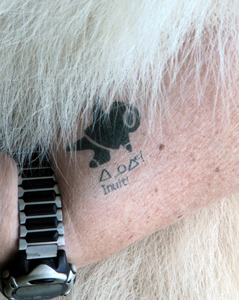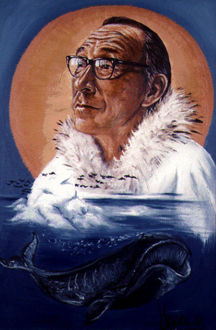From the Editor: An Outsider's Perceptions
The Gaze of Animal Life
In the News
Conducting Dog Feeding Trials on the Antarctic Huskies:
a behind the scenes look at how it got done!
Further Experiments on the nutrition of sledge dogs
How Use of the name Inuit became official
An Examination of Traditional Knowledge:
the case of the Inuit Sled Dog, part 4
Chinook Project visits Northern Labrador
Media Review: Qimmit - A Clash of Two Truths
IMHO: In Transition
Index: Volume 12, The Fan Hitch
Navigating This Site
Index of articles by subject
Index of back issues by volume number
Search The Fan Hitch
Articles to download and print
Ordering Ken MacRury's Thesis
Our comprehensive list of resources
Talk to The Fan Hitch
The Fan Hitch home page
ISDI home page
Editor-in-Chief: Sue Hamilton
Webmaster: Mark Hamilton
Print Edition: Imaged and distributed by the IPL students of the Ulluriaq School, Kangiqsualujjuaq, Nunavik
The Fan Hitch,
Journal of the Inuit Sled Dog International,
is published four times a year. It is
available at no cost online at:
https://thefanhitch.org.
Print subscriptions: in Canada $20.00, in USA $23.00, elsewhere $32.00 per year, postage included. All prices are in Canadian dollars. Make checks payable in Canadian dollars only to "Mark Brazeau", and send to Mark Brazeau, Box 151 Kangiqsualujjuaq QC J0M 1N0 Canada. (Back issues are also available. Contact Sue Hamilton.)
The Fan Hitch welcomes your letters, stories, comments and suggestions. The editorial staff reserves the right to edit submissions used for publication.
Contents of The Fan Hitch are protected by international copyright laws. No photo, drawing or text may be reproduced in any form without written consent. Webmasters please note: written consent is necessary before linking this site to yours! Please forward requests to Sue Hamilton, 55 Town Line Rd., Harwinton, Connecticut 06791, USA or mail@thefanhitch.org
Print subscriptions: in Canada $20.00, in USA $23.00, elsewhere $32.00 per year, postage included. All prices are in Canadian dollars. Make checks payable in Canadian dollars only to "Mark Brazeau", and send to Mark Brazeau, Box 151 Kangiqsualujjuaq QC J0M 1N0 Canada. (Back issues are also available. Contact Sue Hamilton.)
The Fan Hitch welcomes your letters, stories, comments and suggestions. The editorial staff reserves the right to edit submissions used for publication.
Contents of The Fan Hitch are protected by international copyright laws. No photo, drawing or text may be reproduced in any form without written consent. Webmasters please note: written consent is necessary before linking this site to yours! Please forward requests to Sue Hamilton, 55 Town Line Rd., Harwinton, Connecticut 06791, USA or mail@thefanhitch.org
The Inuit Sled Dog International
The Inuit Sled Dog International (ISDI) is a consortium of enthusiasts whose goal is the preservation of this ancient arctic breed in its purest form as a working dog. The ISDI's efforts are concentrated on restoring the pure Inuit Dog to its native habitat. The ISDI's coordinators welcome to your comments and questions.
ISDI Coordinator Canada:
Geneviève Montcombroux, Box 206, Inwood, MB R0C 1P0; gmontcombroux@gmail.com
ISDI Coordinator USA:
Sue Hamilton, 55 Town Line Road, Harwinton, CT 06791, mail@thefanhitch.org

How the use of the name 'Inuit' became official
by Sue Hamilton
I have a tattoo above my wrist. It's not a permanent one but I keep it going as long as I can and then replace it with a fresh one because I like it very much. A packet of them was sent to me by some nice folks up north as part of a "goodie bag". Since I had to retire my much loved polar bear ring when it became fragile and then cracked, this tattoo, created to celebrate 2010 as the year of the Inuit, keeps me feeling connected to the North and all those years Mark and I traveled across arctic Canada and (once) to Greenland. The tattoo reminds me of how we were so warmly welcomed and treated virtually everywhere we traveled and how we felt so comfortable and at ease, even though the predominant language of each community was not our own. We have many fond recollections and my tattoo helps me to remember them.
My uncle has a tattoo on his forearm as well. Only his is permanent, a series of numbers that was applied to his skin very much against his will. He got his tattoo at Auschwitz. Since the subject was so exquisitely painful to discuss, I never did ask him why he didn't have it removed, as there are procedures to make it go away. Maybe the reminder that despite the effort to obliterate personal identity (what I believe to be, when all else has been taken away, the very last thing a person has left), it can indeed be rediscovered – an act of triumph of the human spirit…survival…humanity's struggle of good over its evil side. My uncle is known by his real name, not his tattoo number.
For many years I worked for a very large multi-cultural organization, rich in diversity. Not everyone spoke "the Queen's English" and I often had to work hard understand what was being said. I had nothing but admiration for these visitors to America, for they knew far more English than I knew of their language. And it was most important to me that, if I couldn't speak their language, at the very least I wanted to call them by and pronounce correctly their name as they wished to hear it, not some corrupted version nickname given to them by others who were too lazy to remember and pronounce an original name.
Identity has always been important to me.
I supposed it doesn't matter that he was born in the same country, but every time I hear Jeopardy's Alex Trebek refer to the aboriginal people of the Canadian North by the "E"-word, I recoil as if someone is dragging fingernails slowly across a blackboard. Trebek needs a verbal dope-slap upside his head, in the most polite way of course, because I think he seems to make a point of using that word, as if he knows better but doesn't care.
Well, I do care and so do a lot of others. And, back in 1977, there were two in particular, Eben Hopson and Jon Buchholdt1,2, who cared enough and were respectful enough to make the name "Inuit" official. Mr. Buchholdt recounts how it came to pass:
"I
was at the first Inuit Circumpolar Conference in 1977
and, as Mayor
Hopson's assistant, I wrote most of the resolutions
passed by the Inuit
Circumpolar Commission (ICC) in 1977. I also was
responsible for
organizing the first ICC conference during the period
between summer
1976 and July 1977. During this early organizational
period I worked
closely with the Inuit of Canada's Western Arctic, and
with
Greenlanders active in their home-rule movement. At that
time the word
"Inuit" was not generally known or used by the Alaskan
Eskimo
community, but I learned that it was the proper noun of
choice in
Canada among those active in Canada's land claims
movement. So, when we
organized the ICC, Mayor Hopson decided to adopt "Inuit"
when he
invited the delegates to the early organization meetings
preceding the
first ICC conference in Barrow. I don't believe the word
replaced
"Eskimo" in Alaska. For instance after the ICC was
organized, in 1977
or 1978 in response to bowhead whaling ban by the
International Whaling
Commission, Alaska's whalers organized the Alaska Eskimo
Whaling
Commission to assume management of the American bowhead
harvest.
I think "Inuit" was adopted as the word for the international polar aboriginal community in deference to the Canadian and Greenlandic feeling that "Eskimo" was a European word, originally French, "Eskimaux." In any event, I was sensitive to that feeling, and I advised Eben Hopson to adopt "Inuit" in place of "Eskimo" in the early days of ICC organization."
I think "Inuit" was adopted as the word for the international polar aboriginal community in deference to the Canadian and Greenlandic feeling that "Eskimo" was a European word, originally French, "Eskimaux." In any event, I was sensitive to that feeling, and I advised Eben Hopson to adopt "Inuit" in place of "Eskimo" in the early days of ICC organization."

Original painting of Eben Hopson hangs in the
North Slope Borough building Barrow, Alaska
Artist: Moses Wassilie, permission
courtesy of Jon Buchholdt
Honoring the use of the term "Inuit" is not an issue of "political correctness" (for me another fingernails-across-blackboard term), but a matter of respecting the wishes of the people who prefer to be called by a name of their own choosing, not one assigned to them by a culture other than their own.
1,2
Eben
Hopson began his political life in 1946 as a Barrow city
councilman. Later he was elected to the legislature of
the Alaska
Territory and then to its first state senate. Hopson
helped organize
Alaska's first regional land claims organization for the
Arctic Slope
Inupiat, then serving as the first Vice-President of the
Alaska Federal
of Natives (AFN), and becoming its Executive
Director. In 1970,
Hopson left the AFN to become Special Assistant for
Native Affairs to
Governor William Egan. Two years later, he left that
position and was
elected mayor of the North Slope Borough. In 1976,
Hopson called upon
the Inuit (Eskimo) leaders of Greenland, Canada, the
U.S., and the
U.S.S.R. to form an international organization, called
the Inuit
Circumpolar Conference (ICC). The first meeting of the
ICC, hosted by
Hopson in 1977 in Barrow, was the high point in his
career. Eben Hopson
passed away on June 28, 1980, the opening day of the
Second Inuit
Circumpolar Conference in Greenland. He was 57 years
old.
Jon Buchholdt managed Anchorage's Community Action Agency when he met Eben Hopson in 1969. The two men began collaboration on the development, creation and operation of health clinics in Alaska, beginning with the Bethel Region, then created the Yukon-Kuskokwim Health Corporation and later the Norton Sound Health Corporation. Their friendship remained strong until Hopson passed away. Today Buchholdt operates an Anchorage law office where he maintains the Eben Hopson Memorial Archives.
Information for these biographies was taken from www.ebenhopson.com.
Jon Buchholdt managed Anchorage's Community Action Agency when he met Eben Hopson in 1969. The two men began collaboration on the development, creation and operation of health clinics in Alaska, beginning with the Bethel Region, then created the Yukon-Kuskokwim Health Corporation and later the Norton Sound Health Corporation. Their friendship remained strong until Hopson passed away. Today Buchholdt operates an Anchorage law office where he maintains the Eben Hopson Memorial Archives.
Information for these biographies was taken from www.ebenhopson.com.